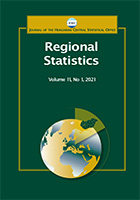Highly qualified social strata in urban areas of Hungarian regional centres from 1980 to 2011
Highly qualified social strata in urban areas of Hungarian regional centres from 1980 to 2011
Author(s): Judit BerkesSubject(s): Social Sciences, Economy, Geography, Regional studies
Published by: Központi Statisztikai Hivatal
Keywords: highly qualified social strata; spatial concentration; spatial-social structure of catchment areas
Summary/Abstract: This study investigates the spatial concentration of highly qualified strata using statistical indicators and methods. Representation of highly qualified social strata means the spatial concentration of groups with higher social status (i.e. education level, foreign language skills, professional skills, and employment level) in the urban regions studied; it does not coincide with mainstream definitions of social capital (based on interaction and networks between social groups). According to one of the most basic assumptions of the complex city concept, settlements with urban status are much more complex in terms of their economic, social, and technical structure and their network relations and interactions than settlements that have not been declared as cities. Simultaneously, the difference in social composition between cities and other settlements cannot be disputed because the concentration of economic resources and activities and the potential of employment and higher income attracts skilled workers to the cities and their catchment areas, resulting in a higher proportion of highly qualified social strata. To meet the increasing needs of the global society and results of the transition to a market economy and globalization processes, a wider range of services is emerging, so the workforce is also undergoing significant differentiation, causing changes in the characteristics and composition of society. This study attempts to study these processes exploring the dynamic trends of change in the spatial distribution of the examined groups. We are looking for answers to questions such as, How can this aspect of society be measured? Is there a difference in the structure of the society of urban centres and their catchment areas regarding highly qualified groups? Has there been a change in the spatial-social characteristics of urban areas over the decades?
Journal: Regional Statistics
- Issue Year: 11/2021
- Issue No: 04
- Page Range: 126-149
- Page Count: 24
- Language: English

